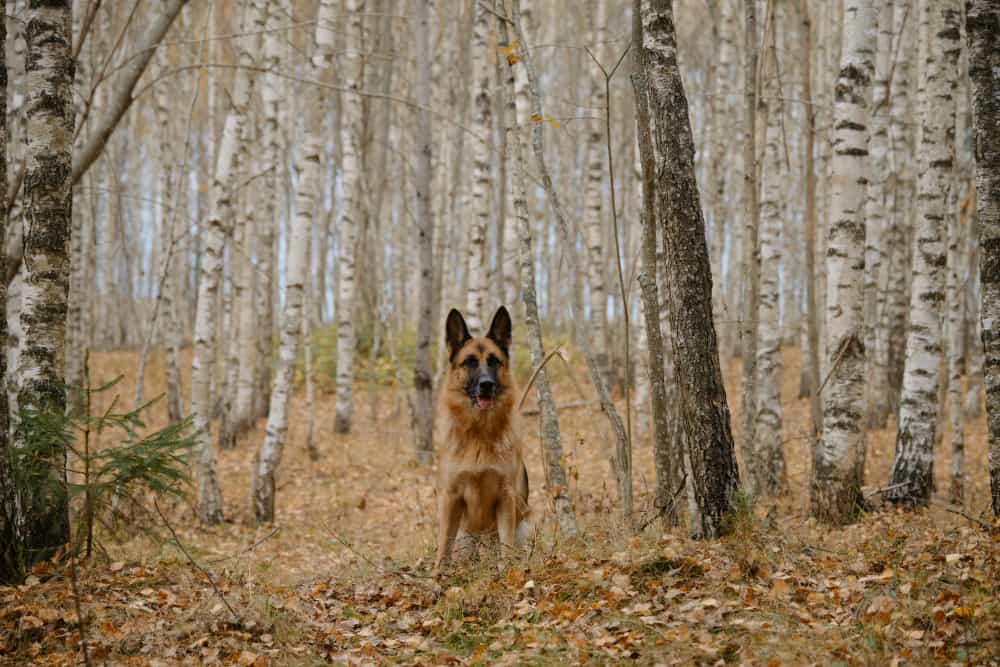Temperature plays an essential role in the well-being of these dogs. Knowing the best temperature for German Shepherds to thrive is key to providing them with a comfortable and enjoyable lifestyle.
The best temperature for a German Shepherd to thrive is 50-80 ℉. Yet, a German Shepherd can tolerate up to between 86- 90℉ for short periods of time. This herding breed is more tolerant of the cold, if acclimated, and can withstand 30℉ for 30-minute to 1-hour intervals.
By understanding the ideal temperature range, you can ensure your pup is comfortable and healthy. If your dog gets too hot or cold, it can be a serious issue, so it’s important to understand the signs.
What are the best temperatures for German Shepherds?
German Shepherds do best with temperatures between 50 – 80℉, according to the Purdue Extension. However, you are probably imagining your GSD spending time romping in the snow or running around on a hot day, so these dogs can definitely tolerate higher and lower temperatures.
Your GSD’s thick, double coat protects them from both extreme cold and heat, but this protection is limited. The main problems you need to watch out for are overheating, dehydration, frostbite, and hypothermia. All of these conditions occur when a dog has been exposed to extreme temperatures for too long.
German Shepherd hot temperature tolerance
If you live in a warm climate, you may be wondering how hot is too hot for your GSD. German Shepherds originated in Germany, where the climate is temperate, with warm summers and cool winters.
So, those temperatures are ideal for your dog. However, there are some other factors such as humidity, environment, airflow, and sun exposure that impact how these temperatures affect your pet.
How hot is too hot for German Shepherds?
Temperatures above 80℉ are going to become uncomfortable for your GSD. If temperatures rise to 86℉ or above, your German Shepherd can overheat.
Some heat acclimated GSD’s can tolerate up to 90℉, according to the American Kennel Club, but at 103℉ your dog is at risk of heatstroke.
Since German Shepherds are large, active dogs, they may generate more heat by playing and running around in these temperatures, increasing their risk of overheating.
If they play in direct sun, these temperatures can be even hotter.
How does humidity affect your German Shepherd?
According to the Humane Society, “Animals pant to evaporate moisture from their lungs, which takes heat away from their body. If the humidity is too high, they are unable to cool themselves and their temperature will skyrocket to dangerous levels, very quickly.”
So, if you live in a climate that gets particularly humid, you will want to take extra care to protect your GSD during hot weather because they can overheat faster.
Do you need to shave your GSD in hot weather to keep them cool?
Your GSD naturally sheds a lot of its fur when temperatures get warmer. Their double coat is layered, and each layer works as a means of insulation. This insulation not only keeps warm air held tight to the skin in cool temperatures, it also traps cooler air in warm temperatures.
In general, a good brush everyday will remove any loose hair that may prevent your dog’s fur from being naturally ventilated. However, if you believe your GSD is overheating, you can shave its fur. It will grow back, but this is not necessary.
How to care for your GSD’s fur in hot weather?
Provide your German Shepherd with plenty of water, shade, and rest during hot weather.
Keep your dog hydrated
Water is essential during sweltering days. According to PetMD, “In general, dogs should drink approximately 1 ounce of water (1/8 of a cup) per pound of body weight each day.” This amount will be more during hot days and heavy exercise. So, your German Shepherd needs access to plenty of water on hot days.
Have fresh and cool water available at all times
Some people think adding ice to their dog’s dish will help them cool down quicker. However, ice can damage a dog’s teeth. A dog can also choke on ice if he is gulping down his water quickly. And, if your GSD is overheating, you want to bring their temperature down slowly. So, cool water is better than ice water.
Provide a shady area
Direct sunlight is going to be hotter than shady areas. Dogs sometimes enjoy sunning, but if it’s a particularly hot day, your dog should have shade to rest in. Shady areas can be nearly 20 degrees cooler than sunny areas.
If you have a GSD with darker fur, that dark fur is going to attract heat more. Darker colors attract more light wavelengths, resulting in more heat.
Set time-out for outdoor time
GSDs are active dogs, but sometimes you need to tell them to go inside to the air conditioning to rest. They love to play and enjoy the weather, but if you notice them panting a lot they seem like they are getting tired, take them inside to rest. This will let your dog cool off, then you can let them back outside later.
How do you spot overheating in German Shepherds?
If your German Shepherd is overheating, he may have the following symptoms:
- Excessive panting
- Extreme salivation
- Bright red gums, tongue, and other membranes
- Labored breathing
- Gasping for air
- Thickening saliva
- Vomiting
- Diarrhea
- Seizure
- Coma
This is a serious condition that needs emergency care. The AKC advises, “Even if you can cool him and he acts normal, rush him to an emergency clinic because his organs may have already been damaged and death could follow.”
Does hot pavement burn GSD paws?
Try to avoid walking your dog on heated pavement. Asphalt can reach staggeringly hot temperatures—150℉ and above! This can damage your dog’s feet. They can get blisters or even burns. Artificial grasses can also cause this kind of injury.
So, when walking your GSD in the heat, try to go down shaded areas and along grassy pathways and avoid asphalt and artificial grasses. You can also get your German Shepherd dog shoes, if he’ll wear them to protect his feet.
German Shepherd cold temperature tolerance
As many German Shepherd owners know, most GSDs love the cold, especially snow. They would play out in the winter weather for hours, if you would let them. They do have remarkable protection against the cold and snow–their double coat—which works as both a water repellant and a warm blanket.
Do German Shepherds get cold?
German shepherds, like all dogs, can experience cold temperatures and may be more prone to feeling cold in certain situations. German shepherds have a double coat, which can provide some insulation against the cold, but they may still feel cold if they are exposed to extreme cold or if they get wet. Yet, these dogs can get too cold, which puts them at risk of hypothermia and frostbite.
Their bodies are also built for cold tolerance. They are tall, so their bellies usually don’t drag in the snow. Their muscles also help generate heat. Their paws also have a network of blood vessels that constantly pump blood to them to keep them from getting to cold as they walk along snowy ground.
How cold is too cold for German Shepherds?
Each individual dog will react differently to the cold, however, anything 40℉ and below is too cold for long exposure. If they are in below 20℉ weather for too long, they can suffer frostbite.
Age, health, wetness, and wind chill affect how quickly your GSD can get too cold. Older and younger dogs get colder faster. If your dog is unwell, he will not tolerate cold as well. If your dog is damp or the wind chill is high, then coldness will set in quicker.
If your dog is playing in the snow and enjoying himself, he may not even notice he’s getting cold.
How do you care for your GSD during cold weather?
If the weather is too cold, keep your GSD indoors. You can also limit their time outdoors. They should be in the cold no longer than 30 minutes, with some well acclimated dogs being able to withstand an hour.
They should still have plenty of water. Water freezes over easily in frigid temperatures.
Also, try to keep them dry by wiping off their fur with a towel when they get damp.
How can you best protect your GSD’s paws in cold weather?
To give your German Shepherd some extra paw protection in cold weather, you can use paw balm or paw wax. Most German Shepherds will pull them off right away, but if you can get yours to wear boots, this will defend their paws against the salt and other chemicals used to treat roads during winter.
If you have a long-haired GSD, trim the hairs around their paws. These can soak up extra moisture and reduce your pet’s temperature more quicker.
Do German Shepherds need to wear sweaters in winter?
German Shepherds have pretty good built-in protection against the cold—their double coat. However, if they seem extra cold or the weather is particularly frigid, you can put a sweater on them. Some dogs tolerate sweaters better than others, so this is a personal preference for you and the dog.
How can you tell if your German Shepherd is too cold?
There are some telling signs that your German Shepherd is getting too cold. For example:
- Haunches (fur on their shoulders and tail) are raised
- Shivering
- Muscle stiffness
- confusion
- Curling up
- Howling, barking, whining
- Lethargy
- Paleness
According to PetMD, “At this point, you may notice that a hypothermic dog’s extremities (ears, legs, feet, paws) appear somewhat pale and feel cool to the touch. While this physiological response can certainly help a dog survive, it does increase the risk that they’ll suffer from frostbite as time goes on.”
Can German Shepherds get frostbite?
Yes, if your dog gets too cold and damp, he can get frostbitten. Frostbite is dangerous. It affects the nose, ears, toes, tail, and scrotum most often. Your dog will start to exhibit the following symptoms:
- Pain
- Cold, brittle skin
- Pale, blue, or gray skin
- Swelling and redness once warmed
- Blistered skin
- Ice around the affected area
- Low body temperature
PetMD advises, “At 15 degrees below zero, it would take approximately 15 minutes. In windy or moist conditions, frostbite can develop within 30 minutes at 32 degrees Fahrenheit.”
Frostbite is an emergency condition and should be treated by a vet.
Do German Shepherds like hot or cold weather?
Each German Shepherd dog is an individual. Some prefer warmer weather and others colder. In general, this is just a lively, enthusiastic dog who enjoys time outside. They can get too hot or too cold, though, so it is important to monitor their outdoor activities.
Conclusion
German Shepherd dogs are built for a wide range of temperatures, but they do best in temperate climates. They are active dogs who sometimes don’t notice how hot or cold they have gotten. It is important to monitor your dog when they go outside and check for signs of overheating or hypothermia. Understanding the ideal temperatures for your GSD will ensure that your dog will be healthy, comfortable, and happy.



